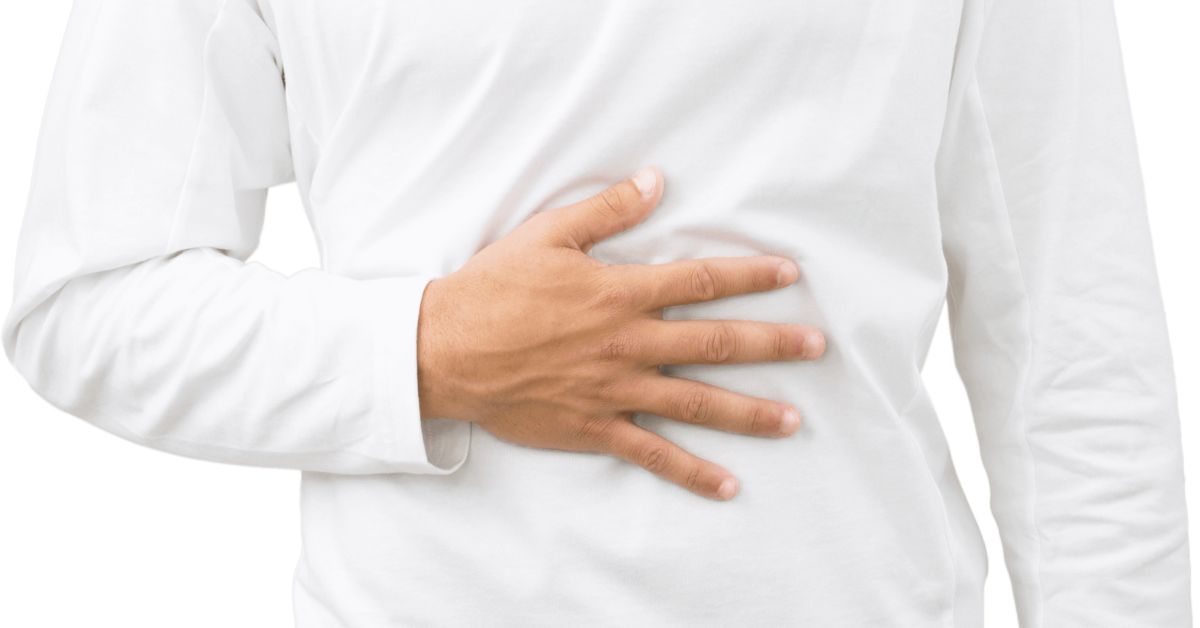4 SIMPLE Indigestion Helpers
Last time we covered Indigestion Causes & Identified The #1 Cause. Today’s Post 4 SIMPLE indigestion helpers can help ease indigestion discomfort and, at the same time, support your digestion.
Here’s what the 4 are and why they work.

In Part 1 Post: The Number 1 CAUSE of Indigestion, we established that having the awareness that LOW stomach acid is the NUMBER 1 Cause of Indigestion means we can avoid the common mistake of reaching for antacids that will lower our stomach acid further.
as many as 70 percent of people experience no benefit from taking antacids, and they actually make the underlying condition (low stomach acid) worse
(1)(bold- underline added)
“as many as 70 percent of people experience no benefit from taking antacids, and they actually make the underlying condition (low stomach acid) worse” (1)(bold- underline added)
Instead of temporary relief that worsens the number one cause of indigestion – (low stomach acid)– we can focus on easing the discomfort while helping to balance our stomach acid simultaneously. The exponential benefit our entire body receives from good working digestion helps us achieve the 1 GOAL of Optimizing Our Body.

4 SIMPLE Indigestion Helpers
- Consuming Caraway, Cabbage, or Swedish Bitters.
- Using a Smaller Plate.
- Taking a Moment to Breathe Deeply.
- Slow Walking.
Sound too SIMPLE? They are SIMPLE, but they support the body in ways that help move toward rebalancing the GI System. (Rebalancing, of course, helps us achieve our 1 GOAL of Optimizing our body.) Here’s how they work.
Let’s Start with Caraway (2)(3)(4)(5)
Caraway helps indigestion through its:
- Antispasmodic qualities reduce cramping, flatulence, and gas.
- Stimulatory action on digestive juices to secrete and support digestion.
- Anti-inflammatory properties calming an irritated GI tract.
Caraway Is A Seed (actually the ‘fruit’ of the plant). It Looks Like This:
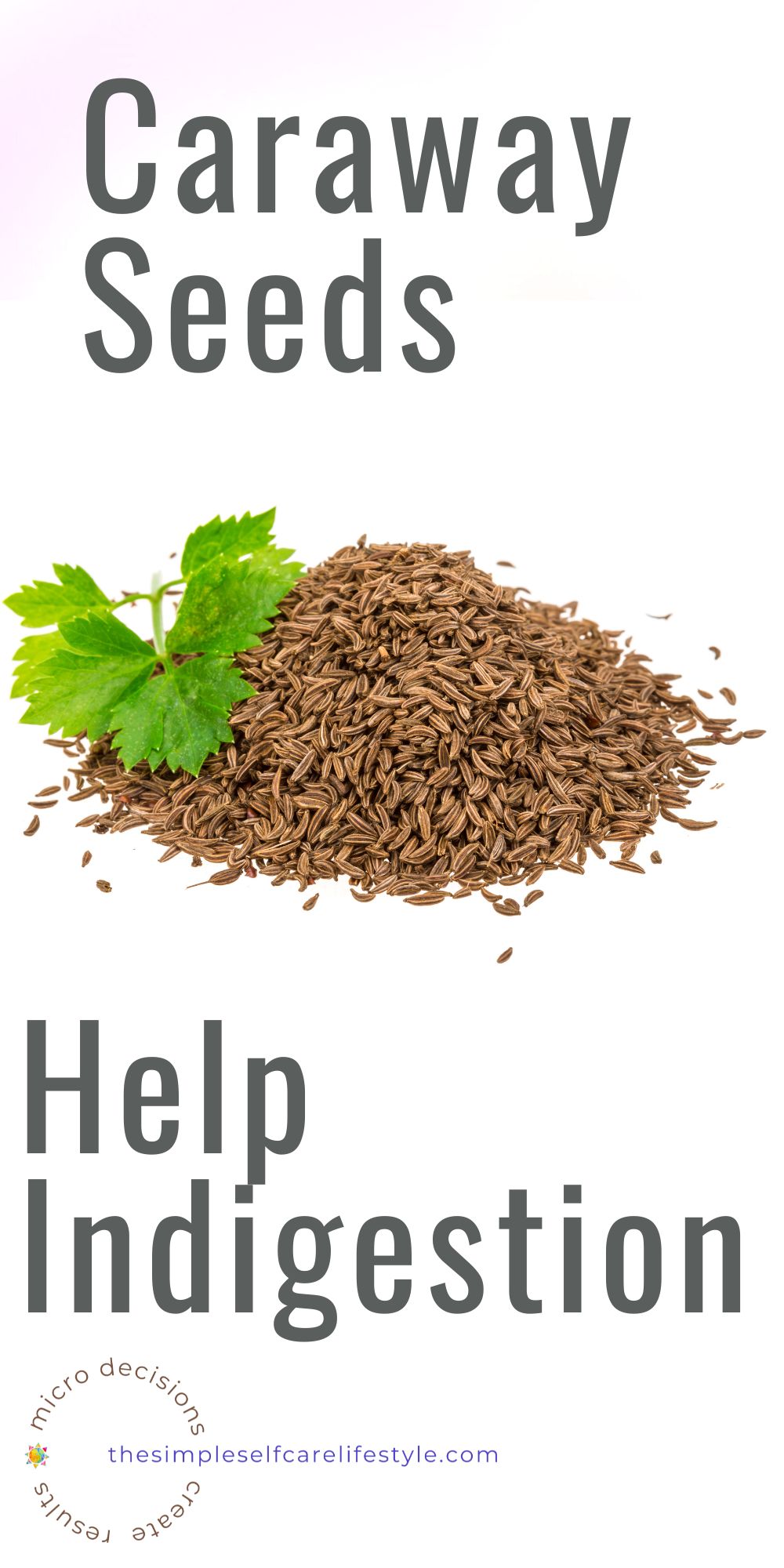
The caraway plant is a member of the carrot family, Umbelliferae.
“Caraway seeds have been used to help reduce symptoms of dyspepsia (Indigestion) for hundreds of years. Now, scientific studies are beginning to back up this folk remedy. Several studies have found that consuming caraway may help reduce uncomfortable symptoms in the digestive tract.” (2)
…Several studies have found that consuming caraway may help reduce uncomfortable symptoms in the digestive tract.”
(2)
“Caraway (Carum carvi L.) is grown for its seeds (botanically fruits) which are used in food, cosmetics, beverage, and pharmaceutical industries” (3)
Caraway is SIMPLE to use.
Its small seeds can be :
- Sprinkled whole or ground onto your meats, stews, vegetables,…
- Brewed into tea.
- Oil (used sparingly) to drizzle or within a dressing.
I use Caraway frequently throughout the week. It has multiple supportive health properties, and it tastes good!
Like Parsley, I keep Caraway on my counter to help prompt me to use it.
I place the caraway seeds in a herb/salt grinder so it is in my sight and at the ready.
Having Caraway in the grinder is a micro-decision that helps me incorporate its use regularly.
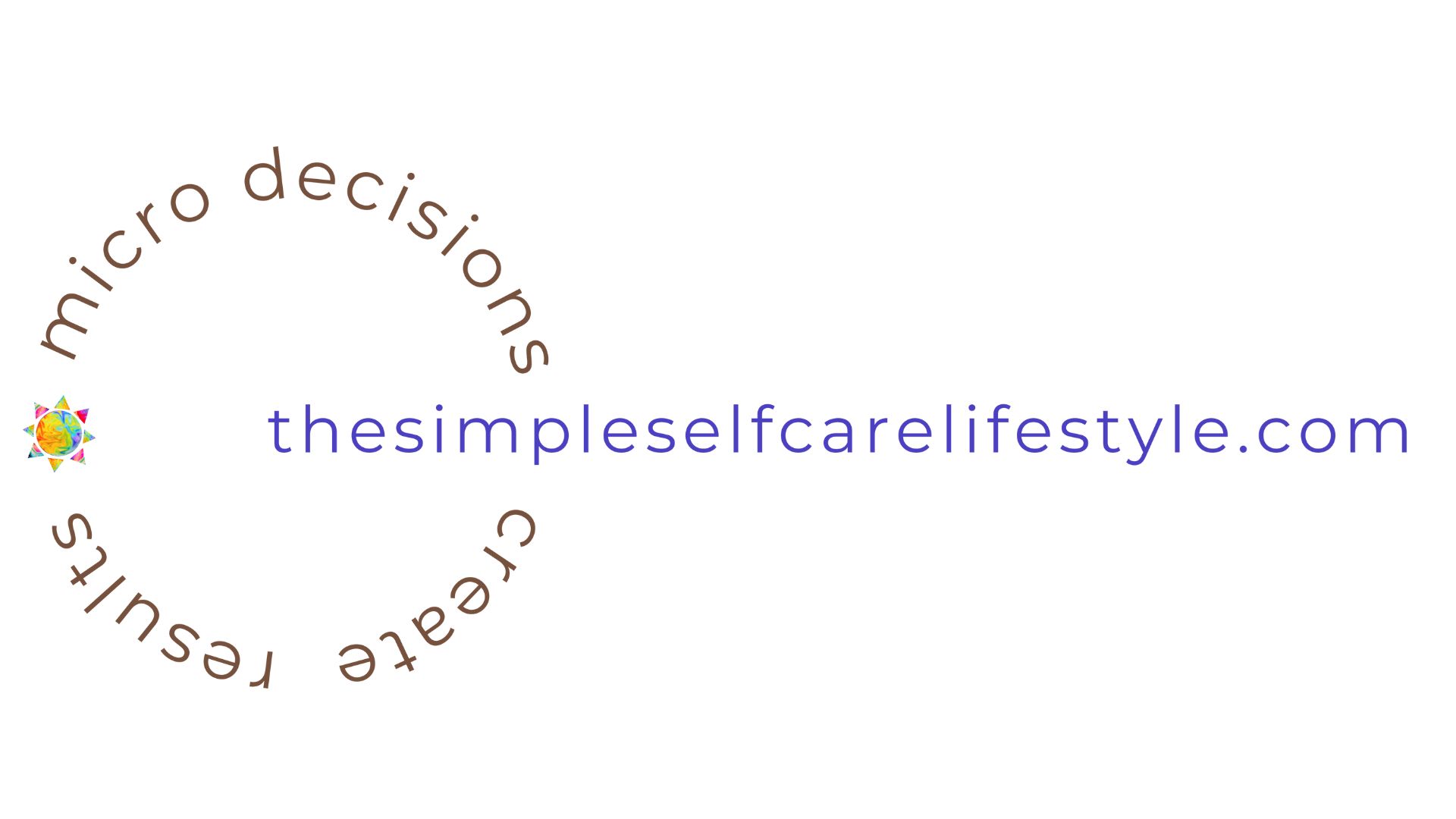
If I keep it tucked away in a spice rack, it’ll add enough resistance that I won’t bother getting it out to use, and honestly, I probably wouldn’t remember to begin with.
By knowing this about myself, I remove the extra step, and voilà, I find myself using it frequently.
Next:
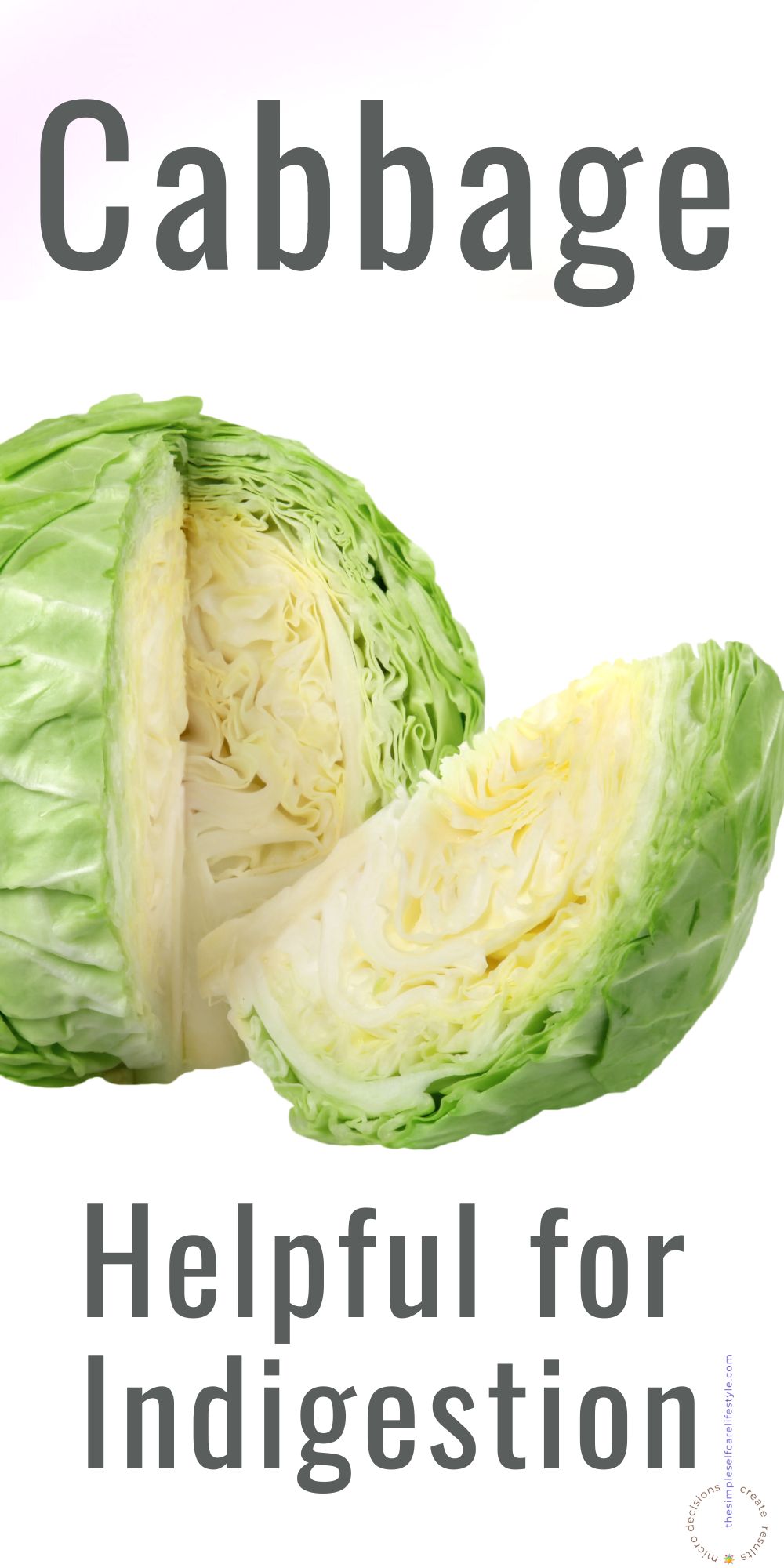
Cabbage
Cabbage helps indigestion through its:
- Anti-inflammatory properties
The anti-inflammatory properties of Cabbage are very effective at soothing and reducing indigestion.
Studies show that Cabbage helps to reduce inflammation and it promotes the healing of ulcers! (19)
Studies show that Cabbage helps to reduce inflammation and it promotes the healing of ulcers!
(19)
The compound known as sulforaphane (20) is what:
- Aids in preventing irritation and inflammation in the digestive tract.
- Helps balance stomach acid levels.
- Reduces bloating and discomfort.
- Over time improves overall digestion.
New to Cabbage?
- Start slowly by having a small portion.
- Plan to use it regularly so you can slowly work up.
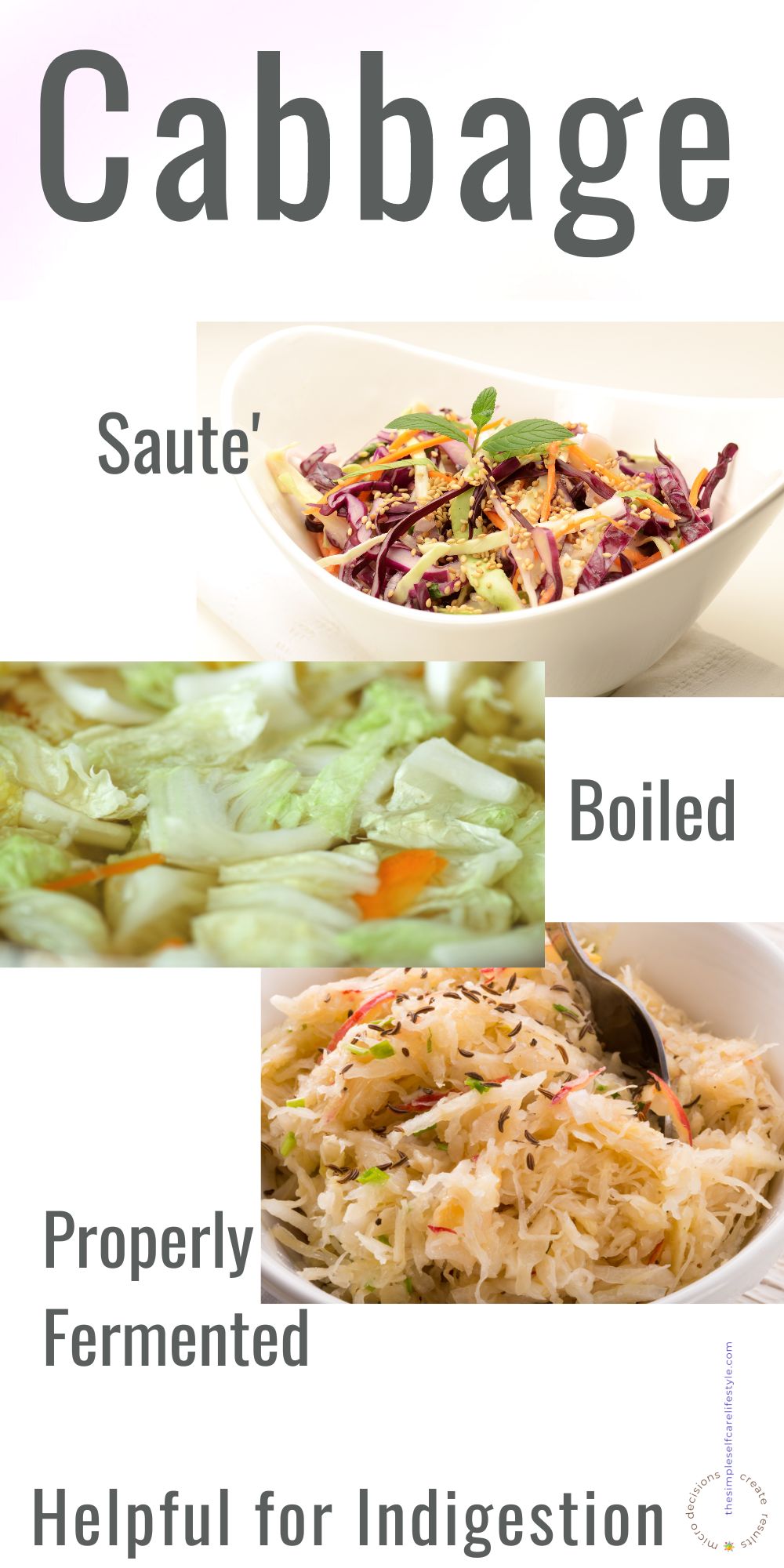
Cabbage is SIMPLE to make.
When having ‘festive’ meals where overindulging is likely, consider including a dish with cabbage.
Ways to have Cabbage:
- Sautéd.
- Steamed,
- Roasted.
- Boiled.
- Raw fermented (Sauerkraut)
Cabbage is Versatile and Yummy!!!
Cabbage is so easy that it’s often my go-to morning vegetable.
I boil strips of Cabbage along with another vegetable like Carrots and enjoy it with my source of protein.
It is bland, making it easy to pair with other vegetables.
My husband prefers sautéing Cabbage with slices of sweet potato.
I’m more likely to cut it into wedges and roast it for main meals.
I add ghee to all of the above, along with a sprinkle of salt and caraway seeds!
Last but not least: properly fermented Sauerkraut.
As a condiment, especially with heavier meals, properly fermented sauerkraut is a fantastic digestive aid. The brand I happen to use is REAL PICKLES.
Now for Swedish Bitters.
There are many brands these days of specialty bitters for you to explore.
Below is the Swedish Bitter my husband uses here in the US.
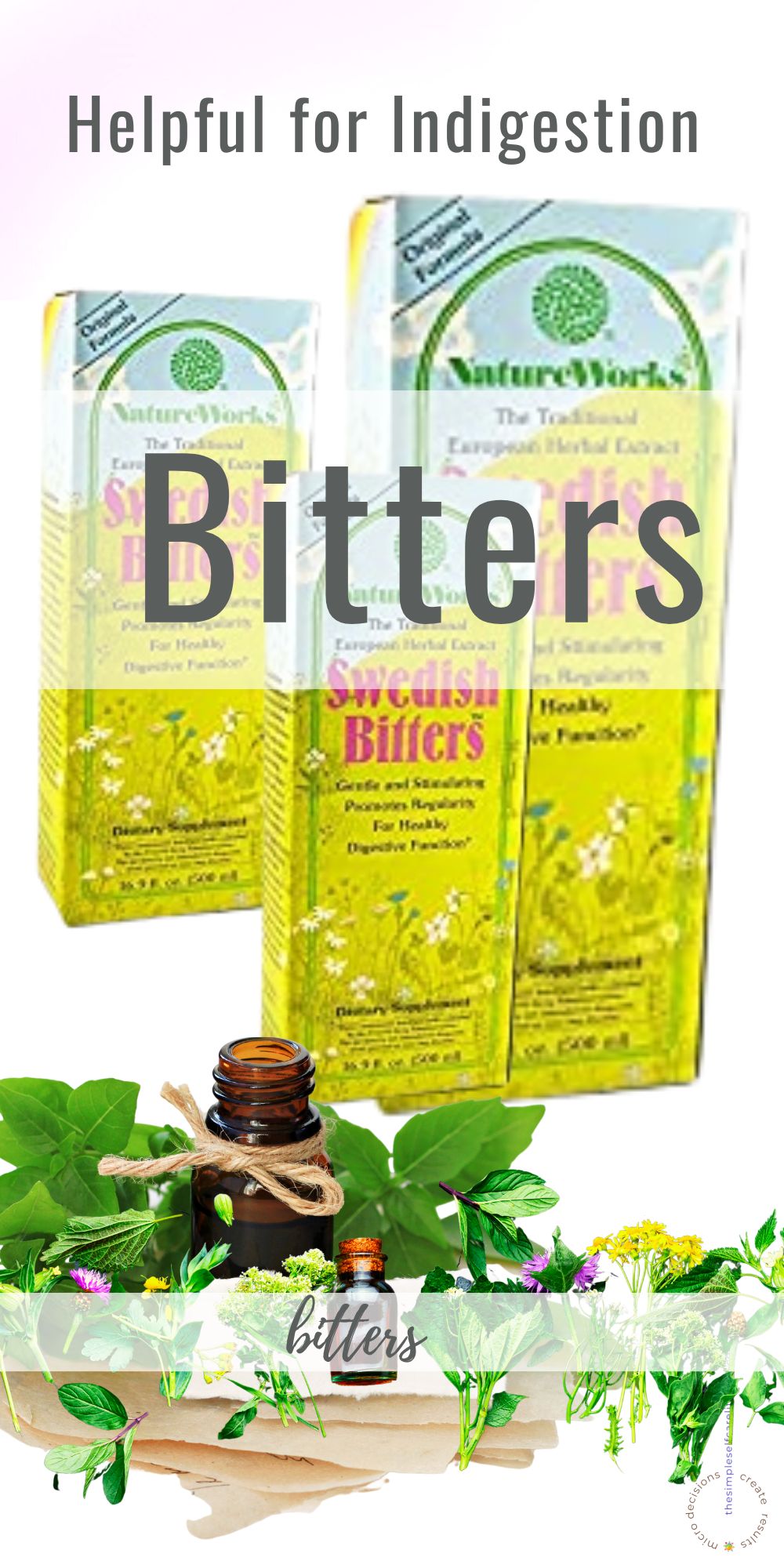
Swedish Bitters
Swedish bitters have been used for centuries in Europe to help aid digestion and provide relief from digestive discomfort.
I experienced its soothing powers firsthand while living abroad.
The stomach distress was, at times debilitating, and my father-in-law was trying to convince me to drink a bitter.

I resisted, but my pain was so uncomfortable at one point that I decided to try it as a last resort.
The way I remember the experience is swallowing it quickly- grimacing at the taste but then intrigued at the warming sensation I felt.
A slow trickling of soothing warmth made its way down my GI tract.
In mere moments the excruciating pain subsided. I was astounded and thankful.
Lucky for me, I resolved the root causes of my digestive issues because, honestly, the bitters are too much for my tastebuds.
My husband, on the other hand, enjoys bitters very much.
Guess what ingredient is often used in Swedish Bitters – Caraway!
Bitters
The Bitters include a variety of ingredients that combined have:
- Anti-inflammatory properties
- Stimulate digestion by increasing bile flow from the liver and improving the breakdown of food by the stomach.
- Are adaptogens that balance out stomach acid levels, helping reduce heartburn and acid reflux.
- Encourage your stomach to release more gastric juice. This can help with heartburn, cramping, and indigestion that has its root in the Number One Cause of Indigestion: Low stomach Acid
If Swedish Bitters work for your tastebuds and food tolerances, it is an excellent indigestion helper.
Each of these 3 food items helps indigestion because they all have-
- Anti-inflammatory properties.
- Stimulate digestion by increasing gastric juices like enzymes, bile…
- Help balance stomach acid levels.

Indigestion Helper Number 2: A Smaller Plate
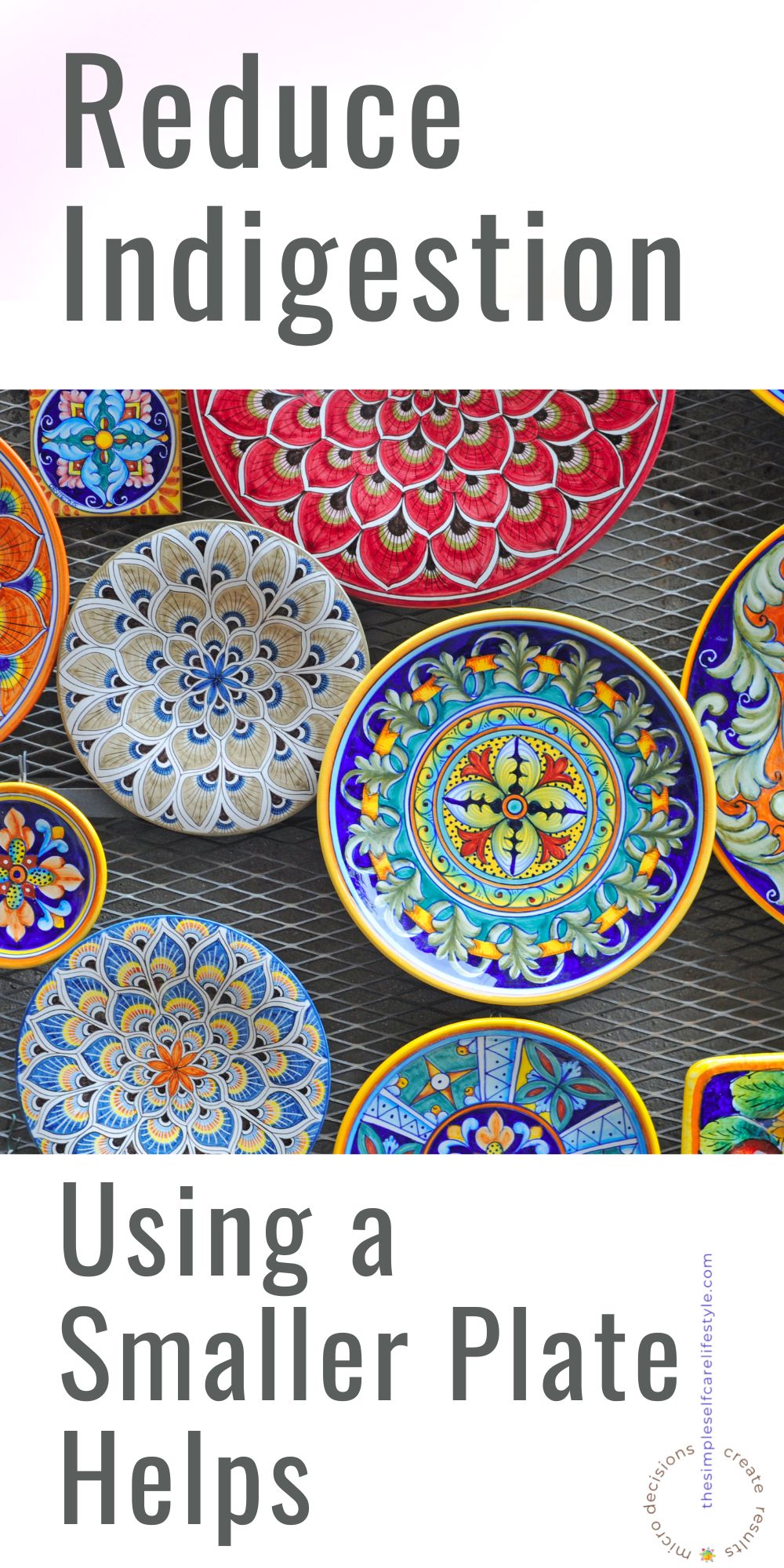
Use A Smaller Plate.
Research shows that the smaller plate visually interacts with our brain and cues our sense of satiety.
The signal that we are satisfied helps us avoid overeating. (10)
A smaller plate also creates a natural pause in our eating.
The extra moment it takes us to refill our plate may be just enough time for our brain to receive the signal that we don’t actually need a second helping.
How This Helps Indigestion
Eating less at one sitting helps indigestion because overeating promotes low stomach acid, (11) the most common cause of indigestion.
Receiving the signal we are satisfied and eating less helps us to avoid overfilling our stomach.
When we overfill our stomach, and there is not enough acid to get digestion going, pressure can build, and our upper valve can weaken. ( picture below)
This scenario can create enough pressure that acid from our stomach can squeeze upward into our esophagus.
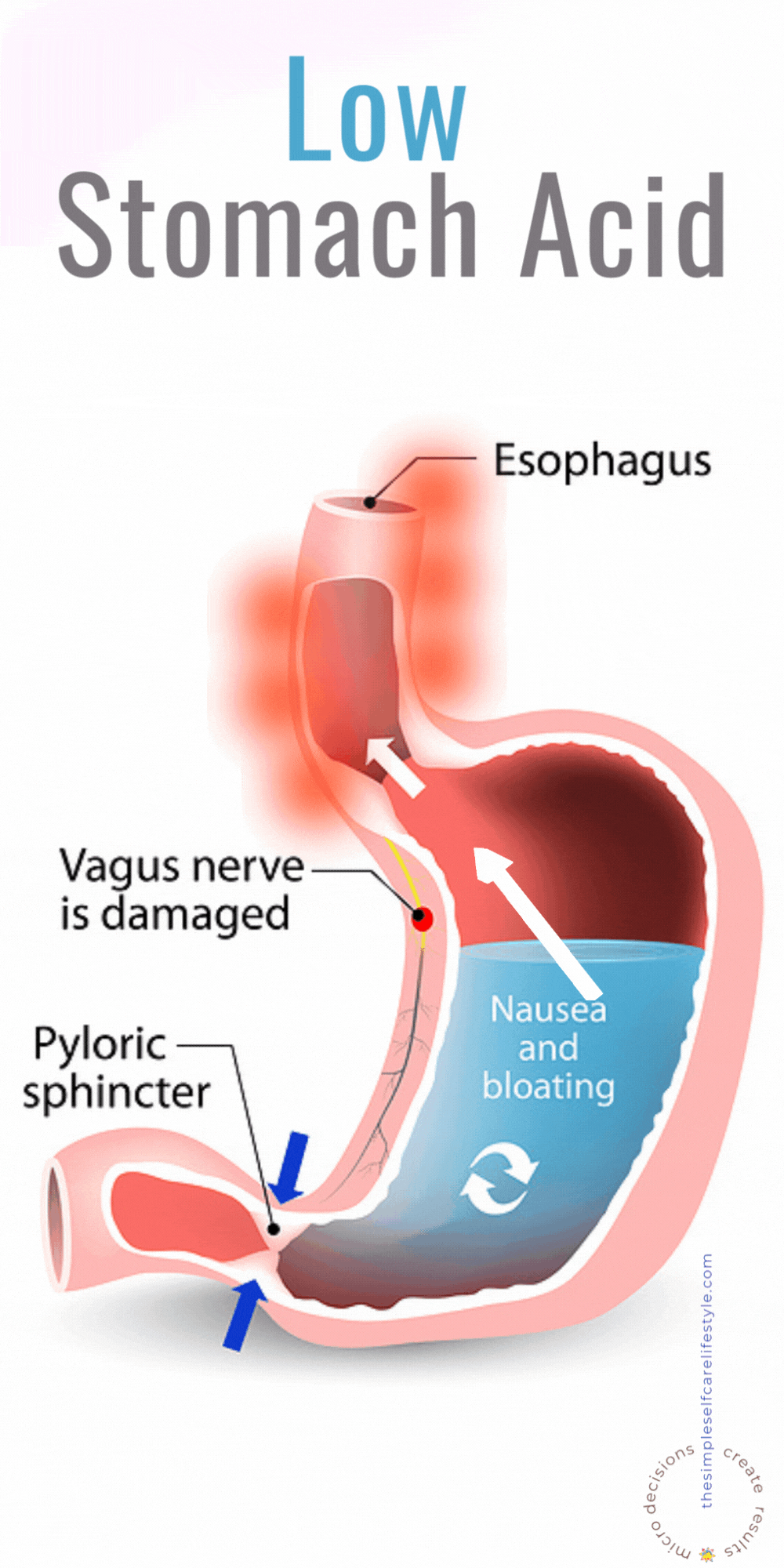
We walk through how low stomach acid creates indigestion in Indigestions #1 Cause.
Now for indigestion helper number three.

Indigestion Helper Number 3:

Take a DEEP – Breath and Slowly Exhale.
Take a moment to breathe slowly and deeply.
A slow deep breath does a few things. To start it:
- primes your digestion by allowing time for the smell of your food to stimulate digestive enzymes in your mouth.
Your Sense of Smell Signals Your Brain
“When you see or smell food, your brain sends a signal that causes your salivary glands to “make your mouth water” to prepare you to eat.” (7)
“Saliva has an enzyme called amylase that breaks down starches (complex carbohydrates) into sugars, which your body can more easily absorb. Saliva also contains an enzyme called lingual lipase, which breaks down fats.” (8)
Even One Single SLOW DEEP breath can:
- help relax the body enough to
- prompt our nervous system to come down a notch.
Bringing the stress level down a notch improves digestion.
How Taking A Deep Breath Works So Well.
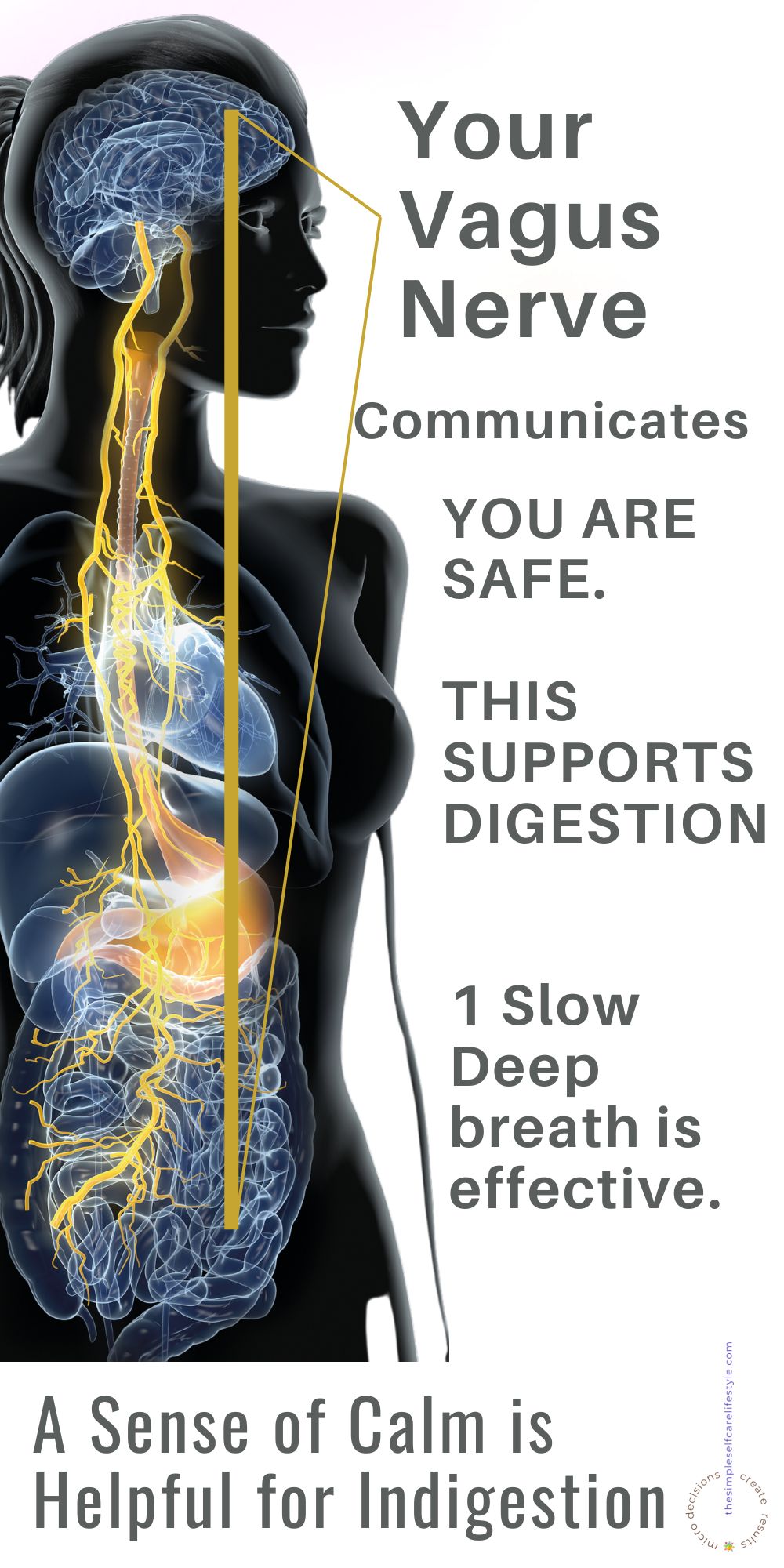
Your Vagus Nerve (shown in yellow above) communicates you are safe. (Core Concept 1 of Self Care) The ‘you are safe signal’ supports digestion.
Slowing down and focusing on taking a SLOW DEEP breath throughout the day is actually one of the best ways to improve chronic indigestion.
We are so accustomed to stress we are often not aware that:
- Our body is holding tension.
- We are breathing shallowly.
- Hormone levels are surging around.
To interrupt this chronic stress signal, our body is beautifully designed in a way that empowers us to be able to break the stress loop with DEEP, SLOW Breathing. Link to AM and PM breathing videos.
Repeatedly making the Micro Decision to incorporate a slow DEEP breath works wonders.
Interrupt Your Stress Loop
Interrupting your stress loop is actually KEY when it comes to helping chronic indigestion discomfort.
This is because our vagus nerve is in direct communication with the entire GI tract.
When we are under stress, our stomach acid GOES DOWN. (The # 1 Cause of Indigestion)
Simplified into 1 sentence: Stress signals our body to shuttle blood away from the GI tract.
Our body is set up to always try and help us. ALWAYS. This mechanism of not prioritizing digestion when under stress is a good thing, especially when we need to run fast!
The blood shuttling away from digestion and redirected toward our muscles is set up to give us a better chance of survival. When the muscles have the extra blood that they need to flee or fight, we are more likely to survive the threat we are facing.
Digestion is Impaired Under Chronic Stress
The body does NOT count digestion as essential when in fight or flight mode.
ALL secretion of the digestive enzymes & juices decreases when under stress.
Is it any wonder indigestion is so prevalent!?
“More than 60 million Americans experience heartburn at least once a month. Some studies suggest that more than 15 million Americans experience heartburn symptoms each day” (22)
…studies suggest that more than 15 million Americans experience heartburn symptoms each day
22
Our body does not register a difference between a real threat like a tiger coming for you and a bad day at work, so it is essential to use your awareness to recalibrate the stress loop, OFTEN!!!

One DEEP, Slow Breath Will Help You Do That.
You can support digestion and help resolve indigestion by slowing down for a moment before each meal. It truly only takes a moment.
Here is a video that is less than a minute. It guides you through 4 breaths so you can practice the timing of a slow breath.
You may laugh- who needs to practice breathing slowly!?! We all do.
At first, it’ll feel crazy slow.
After doing it day in and day out, your one breath will be slower than the initial four you did!
Plus, once you have the hang of a good- slow- deep breath, you will find one breath is enough to trigger your vagus nerve and improve your GI system’s ability to digest. That is the power of Micro Decisions!
Grab Your Micro Decision App

The Simple Self Care Lifestyle
MOtivator APP
Last But Not Least of The 4 Indigestion Helpers: Walking.

Back to my father-in-law for a moment.
When we would stay at his home, immediately after the meal, he would say:
“Nach dem Essen sollte man sich ausruhen oder besser noch tausend Schritte tun.“(“After eating you should rest or better yet take a thousand steps.”)
We would all head out the front door and walk to the park for an after-meal stroll.
When I looked it up, I learned this phrase was not a Heinrich original, but it was a centuries-old idea that a “digestion walk” was important after eating meals.
Science supports that walking post-meal contributes to better digestion. (14) (15) And is helpful for indigestion.
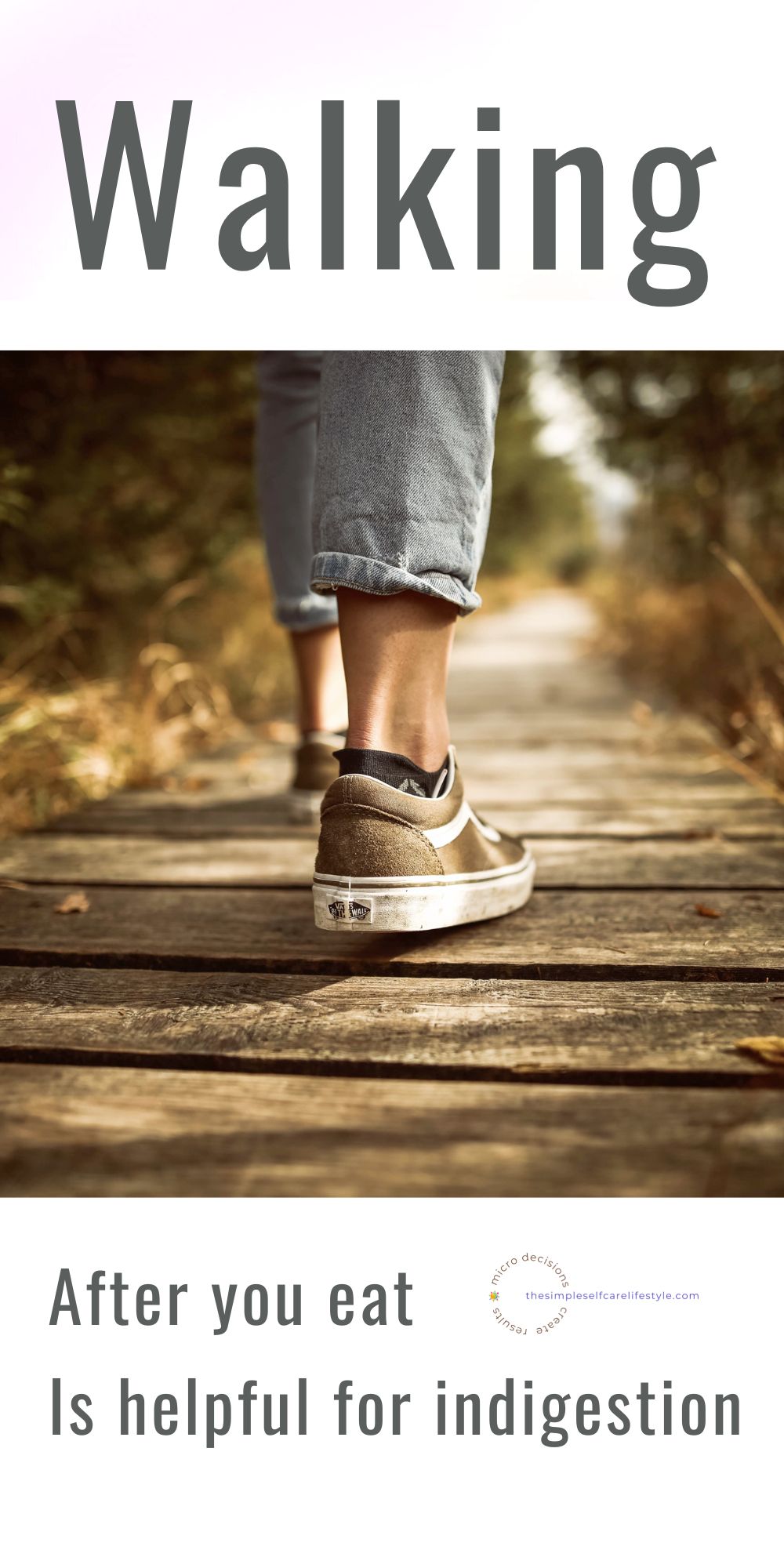
You do not need to ‘go for a walk‘; simply walking around the house will do the trick.
There’s a multitude of benefits walking for a few minutes post-meal offers the body like: (16)
- Blood sugar control
- Better use of body fat
- Improved Gastro hormone regulation
…research has found that walking helps speed up the time it takes food to move from the stomach into the small intestines. This could help improve satiety after eating. There’s also evidence that links this type of faster digestion with lower rates of heartburn and other reflux symptoms.
(21)
How does walking a few minutes post-meal help indigestion?
“Research has found that walking helps speed up the time it takes food to move from the stomach into the small intestines. This could help improve satiety after eating. There’s also evidence that links this type of faster digestion with lower rates of heartburn and other reflux symptoms.” (21)

2 Extra Well Known Indigestion Helpers

Wrapping up with a quick mention of two additional suggestions for chronic indigestion sufferers.:
- Finish eating 3 hours before bedtime, as it is associated with a sevenfold increase in indigestion/reflux. (17)
- Avoid your bio-individual food triggers. (18).

Re-Cap- 4 SIMPLE Indigestion Helpers:
Caraway, Cabbage, or Swedish Bitters.
Using a Smaller Plate.
Taking a Moment to Breathe Deeply.
Slowly Walking.
Have an indigestion helper that you find effective?? Send your tip to: [email protected]

🌿 References & Resources for you and more POSTS that may interest you below!
4 Caraway – an overview | ScienceDirect Topics. (n.d.). Retrieved December 8, 2022
6 Michael T. Murray ND, in Textbook of Natural Medicine (Fifth Edition), 2020
References/Resources Continued…
References/Resources Continued…
22. U.S. National Library of Medicine. (n.d.). Heartburn: What you need to know | NIH MedlinePlus Magazine. MedlinePlus. Retrieved December 9, 2022,

